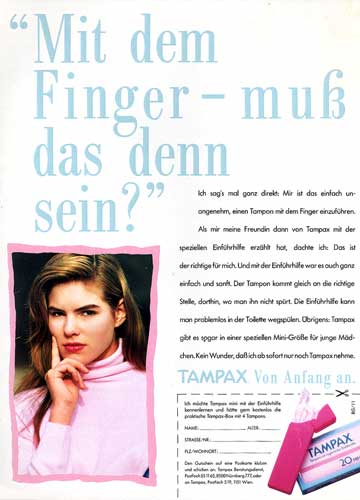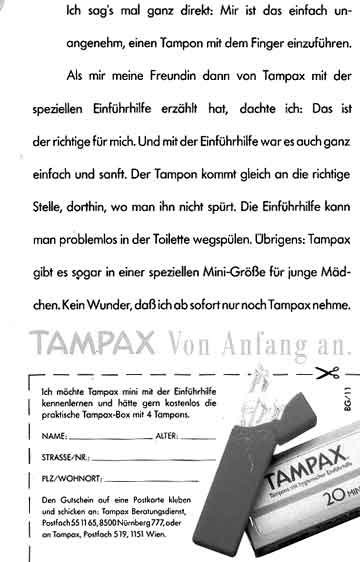Ad Aug 1965 -
actress Susan Dey ad,
1970 - gymnast Mary Lou
Retton ad, 1986 - ad,
British, 1994 (the thong advantage)
See more Tampax items:
American ad from August
1965 - nudity in an ad: May 1992 (United
Kingdom) - a sign
advertising Tampax during World War II - the
original patent
- an instruction
sheet from the 1930s
See a Modess True or
False? ad in The American Girl magazine,
January 1947, and actress Carol
Lynley in "How Shall I Tell My Daughter"
booklet ad (1955) - Modess
. . . . because ads (many dates).


|

Convincing women to break with
tradition and use Tampax menstrual
tampons:
Ads, Germany
(1989) and U.S.A (1953)
Although an American osteopath
invented Tampax, a German woman
immigrant to America was the president
of the first company selling Tampax in
America (read some history)
and that tampon itself might have
reached Germany around the time Hitler
came to power; the Dutch and the
French had it by 1938 (ads and the
French Tampax
here).
But Americans at least have had
trouble accepting tampons from the
beginning, what with worrying about virginity,
whether the little devils would get
lost and whether they're safe or not
(see a newspaper campaign against Rely and the
infamous tampon
itself).
The main tampon in Europe for
decades was o.b., which had no
applicator (see an early folder).
Like probably most American women,
some Germans didn't like sticking
their fingers into their bleeding
vaginas, teeming with even more
bacteria than usual because of the
alkalinity of menstrual blood (read
more here).
The
Tampax ad below describes Tampax's
appeal.
Earlier, in the U.S., that
representative of authority and
health, the doctor, tried to convince
a visitor to use Tampax. The company
had used medical authority for years
to push its 'pons by writing on its
boxes that The Journal of the American
Medical Association had accepted its
advertising. But Kotex and other
companies did the same thing; and of
course a nurse
invented Kotex.
Tampax is famous for promoting
freedom from inconvenience; read the humor page
for how that tampon can help people
ride bicycles and swim, even if they
aren't women.
|
"Do
I have to use my
finger??" wonders the woman,
finger against her face, which
heightens the point the ad makes. My best friend in my
many-year stay
in Germany, an author of books
about that country, explained to me
his law, based on reading American and
German publications: Davis's Law
observes that writers will
unconsciously repeat words, or similar
words, or images in nearby sentences.
But here I think it's intentional and
apt. My translation of the
German ad lies below the second
picture, which is an enlargement of
the text in the ad.
|
Thirty-six years before the German
ad, an American physician (below) just
tries to convince his patient to use
tampons, much less emphasize the
applicator, which he mentions
seemingly as an afterthought in one
sentence. [Continued below the
ad.]
|
 |
 |
My translation of the
text:
"I'll get to the point: I find
it simply unpleasant to put a
tampon in with my finger. When
my girlfriend told me about
Tampax with the applicator I
thought, that's for me. And
using it was simple and
gentle. The tampon gets to the
right spot, where you don't
feel it. You can toss the
applicator into the toilet -
no problem. And there's a
Tampax Mini for young girls.
No wonder that from now on
I'll only be using Tampax."
Big
words: "Tampax,
from the beginning."
|
|
 |
By 1953 Americans had had
maybe 20 years of tampons (for
example Wix,
Kotex, B-ettes,
Cashay,
Dale
and Lox),
but women still preferred pads
- as I believe they do today.
In 1952 Tampax even ran an ad in
a medical publication
explaining its virtues to doctors.
An earlier attempt to convince
the public was Dr. Dickinson's
comparison of tampons and pads
in The
Journal of the American
Association (a shorter
version appeared in Consumer
Reports) which tilted
way toward tampons; Dr.
Dickinson sometimes worked for
Tampax.
|
|
|
© 2006 Harry Finley. It is
illegal to reproduce or
distribute work on this Web site in
any manner or
medium without written permission of
the author. Please report suspected
violations to hfinley@mum.org
|
|